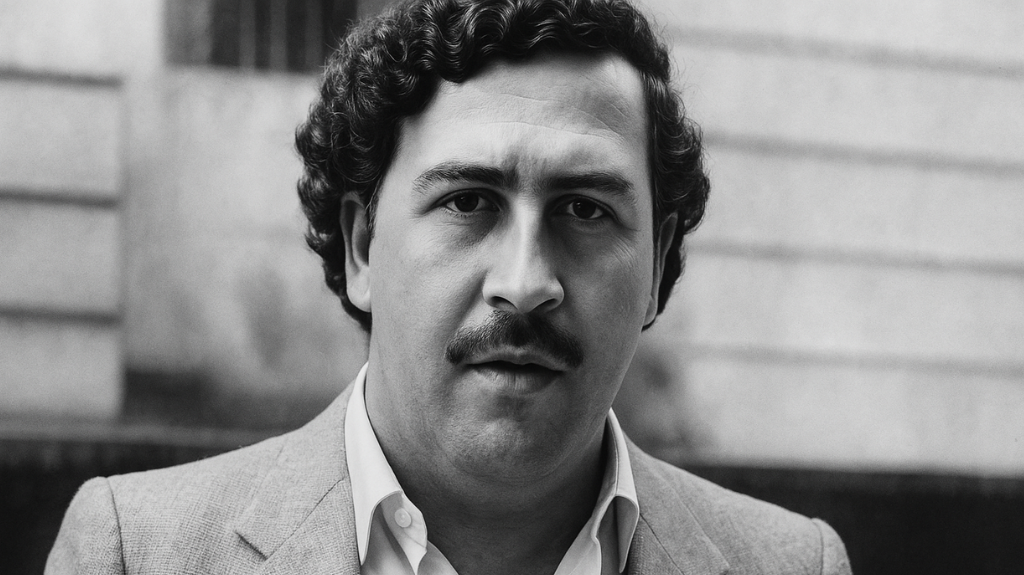Pablo Escobar, the Colombian drug lord who established a multibillion-dollar cocaine empire and ruled with both kindness and fear, is most likely someone you have heard of.
However, the most frequently asked question is: what actually transpired in Pablo Escobar’s last moments, and when did he die?
On the surface, the answer is straightforward: he passed away in Medellín on December 2, 1993. The entire story, however, is far more spectacular, with myths, betrayals, manhunts, and a chase that resembled a scene from a movie.
We’ll examine Escobar’s final days, how the police found him, and why his passing continues to captivate people thirty years after in this blog.
From Nowhere to “The King of Cocaine,” Pablo Escobar
Escobar was among the wealthiest persons in the world prior to his downfall. He started out as a small-time street criminal in 1949 and worked his way up to become the leader of the notorious Medellín Cartel in Rionegro, Colombia.
He made billions of dollars annually by controlling about 80% of the global cocaine trade by the 1980s.
In Colombian society, he evolved into a multifaceted figure:
- A vicious murderer who carried out vehicle bombings, assassinations, and even a passenger jet bombing.
- A “Robin Hood” for the impoverished in Medellín, constructing homes, schools, and soccer fields.
Because of his dual identity, he was reviled by many and loved by others.
The Prison of Escobar That Wasn’t Actually a Jail
Escobar made a strange agreement when he turned himself in in 1991: he would remain in a prison he had built.
The location, known as La Catedral, had upscale suites, a bar, and a football pitch.
However, he continued to labor. He carried on managing the Medellín Cartel from within. The Colombian government tried to transfer him to a real prison in 1992 after reaching a breaking point. One of the largest manhunts in history began when Escobar escaped.
The Manhunt Year
Escobar was on the run for more than a year following his escape.
- The Search Bloc: A specialised Colombian police force that received training from the United States.
- The CIA and DEA: Supplying intelligence and technology.
- Los Pepes: A vigilante organisation composed of rival cartels and Escobar’s adversaries.
Escobar’s life turned into a game of survival since there were enemies everywhere. He relied on radio phones—an old habit that would soon betray him—and alternated between safe houses and reliable bodyguards on a regular basis.
December 2, 1993: The Last Day of Escobar
Escobar called his family on December 1st, his 44th birthday. He called his son again the following day. Authorities were able to track him down to Los Olivos, a middle-class neighbourhood in Medellín, thanks to that one mistake.
The Final Events
- Escobar was in hiding with El Limón, his faithful bodyguard.
- With the help of the phone signal, Search Bloc troops overran the area.
- El Limón and Escobar attempted to flee over the rooftops.
- A ferocious gunfight ensued.
Escobar sustained many wounds, including to the legs and body, before being fatally shot in the head.
The last bullet is still up for dispute. Was it fired by the police? Or did Escobar actually shoot himself to escape being apprehended? Although his family firmly thinks the latter, Colombian forces are given credit in the official narrative.
Colombia Following Escobar
For Colombia, Escobar’s passing was bittersweet. On the one hand, it put a stop to the terror he had sparked with bombings, political corruption, and assassinations.
However, a lot of people in underprivileged areas lamented the man they perceived as a provider.
Following his passing:
- The Medellín Cartel fell.
- Up until the middle of the 1990s, the Cali Cartel dominated the drug trade after rising to prominence.
- The bloodshed and trafficking never really stopped, even though the drug war changed.
Why We Are Still Enticed by Pablo Escobar
Escobar’s tale is still relevant decades later. His mystique endures thanks to documentaries, books, and shows like Narcos.
He is viewed as a folk hero by some and a villain by others. In actuality, he was both, and his life serves as a reminder of how violence, wealth, and power can devastate a nation.
A Brief Overview of Escobar’s Past Year
- July 1992 – Escapes from La Catedral prison.
- 1992–1993 – Always on the run, being pursued by vigilantes, the DEA, and the police.
- December 1, 1993 – Still hiding at the age of 44.
- December 2, 1993 – A phone conversation led to his death in Medellín.
Concluding Remarks
So, to answer the question: when did Pablo Escobar die?
➡️ He was gunned down on a Medellín rooftop on December 2, 1993, when he was 44 years old.
However, the tale doesn’t stop there. The Medellín Cartel fell apart after his death, but the drug battles in Colombia continued. Part intrigue, part terror, his tale endures around the world.
FAQs
1. What was Pablo Escobar’s death date?
He passed away in Medellín, Colombia, on December 2, 1993.
2. At what age did he pass away?
The day prior, he had celebrated his 44th birthday.
3. Pablo Escobar was shot by whom?
Although his family believes he shot himself, Colombian police officially declared him dead.
4. In what location did he pass away?
In Medellín’s Los Olivos neighbourhood.
5. After his passing, what became of the Medellín Cartel?
When it fell apart, competitors like the Cali Cartel seized control.
6. Was Escobar adored in Colombia?
Yes, his construction of homes and schools won him the admiration of many impoverished people. However, he was also dreaded for the bloodshed he incited.
7. What continues to make Pablo Escobar so well-known?
He is one of the most infamous people in history because of his tale, which combines politics, fortune, crime, and myth.


